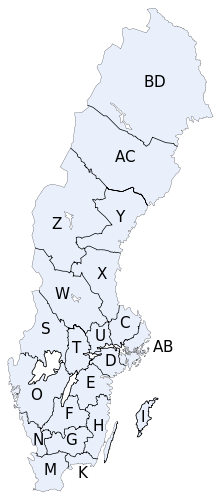This article needs additional citations for verification. (March 2020) |
| Counties of Sweden Sveriges län (Swedish) | |
|---|---|
 | |
| Category | Unitary state |
| Location | Sweden |
| Number | 21 |
| Populations | Least: Gotland, 61,001 Most: Stockholm, 2,415,139 |
| Areas | Smallest: Blekinge, 2946.4 km2 Largest: Norrbotten, 98244.8 km2 |
| Government |
|
| Subdivisions | |
 |
|---|
| Administrative divisions of Sweden |
|---|
| Counties of Sweden |
| Municipalities of Sweden |
| List of municipalities |
| Other divisions |
|
|
|
The counties of Sweden (Swedish: Sveriges län) are the administrative subdivisions of Sweden. They are not regarded as geographical areas by Swedes as they are not connected to dialects or identity, which is a role fulfilled by the historical provinces of Sweden (Swedish: landskap). Sweden is today divided into 21 counties; however, the number of counties has varied over time, due to territorial gains/losses and to divisions and/or mergers of existing counties. This level of administrative unit was first established in the 1634 Instrument of Government on Lord Chancellor Count Axel Oxenstierna's initiative, and superseded the landskap, in order to introduce a more efficient administration of the realm. At that time, they were what the translation of län into English literally means: fiefdoms. The county borders often follow the provincial borders, but the Crown often chose to make slight relocations to suit its purposes.
In every county there is a county administrative board (länsstyrelse) headed by a governor (landshövding), appointed by the government, as well as a separate regional council (region). In the county of Gotland however, the county's only municipality has adopted regional responsibilities.
The aims of the county administrative board are to supervise local state administration (that is not otherwise assigned to other government agencies), and to coordinate political goals with the central government. The regional council is the elected regional political assembly that oversees the municipal affairs of the county, primarily in regard to public healthcare, public transport, and culture.
Beginning in the 2000s, many major government agencies have reorganised from a countybased subdivisional structure into larger geographical or functional areas. This include the Swedish Tax Agency (1 January 2004), the Swedish Social Insurance Agency (1 January 2005), the Swedish Public Employment Service (1 January 2008), and the Swedish Police Authority (1 January 2015).